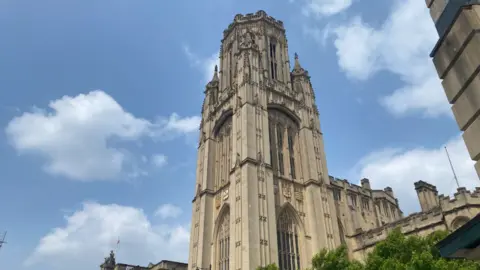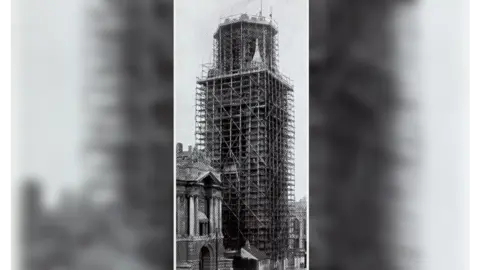Iconic building's 100th anniversary celebrated
The 100th anniversary of one of Bristol's most iconic landmarks has been celebrated.
The Wills Memorial Building was built as a memorial to the tobacco magnate Henry Overton Wills and opened by King George V and Queen Mary on June 9 1925 in a ceremony that saw thousands lining the streets.
Construction of the building, seen by many as the heart of the university area of the city, began in 1915 but was delayed by the First World War.
It was one of the last gothic buildings to be built in England and attracted national attention in the run-up to its grand opening.
The University of Bristol marked the centenary with a special ringing of the tower's bell and commissioned a poem by Dr Lawrence Hoo that references the building's links to the transatlantic slave trade through the Wills family.
"If law made it legal, does that make it right, would justice have weight, if it only wore white?" it reads.

 University of Bristol
University of Bristol"We have newspaper cuttings from across the Bristol and national press showing pictures of the king and queen and events from the day - it just shows the level of interest there was across the country," said Rachel Gardner, Senior Archivist at the University of Bristol.
"The stories focus on the famous people you could see at the procession but also on people like Granny Mary Jarrett, who was 104 years old and was given special permission to ride in a taxi as part of the procession, and met the king."
 University of Bristol
University of Bristol"There's also a lot about how the citizens of Bristol were so well behaved and only a handful of wallets went missing that day so everyone should be very proud of themselves.
"It was specifically requested by the king that there wasn't a costly decorations scheme but the mayor wrote in the press asking everyone to decorate as freely as possible - it really involved the whole city," she added.
The building narrowly avoided destruction just 15 years after its completion when incendiary bombs dropped during The Blitz caused the roof of the Great Hall to collapse - leaving burn marks on the floor that can still be seen today.
 University of Bristol
University of BristolWinston Churchill - who was chancellor of the university - inspected the damage the next day and insisted that a ceremony to award honorary degrees still went ahead.
The Great Hall has long been repaired and now welcomes hundreds of students for graduation ceremonies every year.
It has also welcomed some famous people to receive honorary degrees, including James Blunt and the former leader of the Soviet Union, Mikhail Gorbachev.

The building's opening was marked by 21 chimes from Great George - the 9.5 tonne bell that sits at the top of the tower.
To mark the anniversary the university organised a special manual ringing, as it would have been done in 1925.
The bell is the third largest that can be manually swung in the country, and when that happens it can be heard much further than its normal two-mile radius.

"When we get the bell ringing there is a lot more energy involved, and the speed the clapper hits is much higher," said Matthew Tosh, bell ringer with the University of Bristol Society of Change Ringers.
"But getting the bell that high is really physically demanding and even with the strongest, heaviest big bell ringers we've never managed to get it more than half way up," he added.
Great George is normally only rung manually for special state occasions such as royal deaths and coronations.
Follow BBC Bristol on Facebook, X and Instagram. Send your story ideas to us on email or via WhatsApp on 0800 313 4630.
